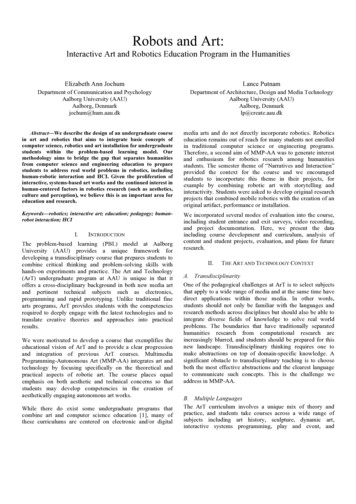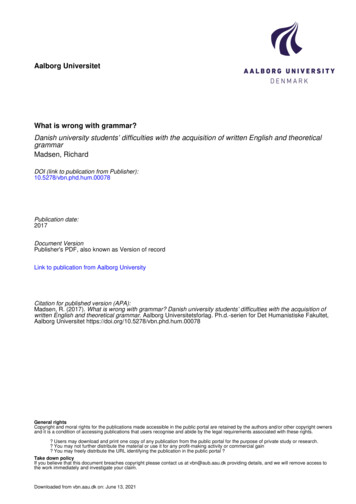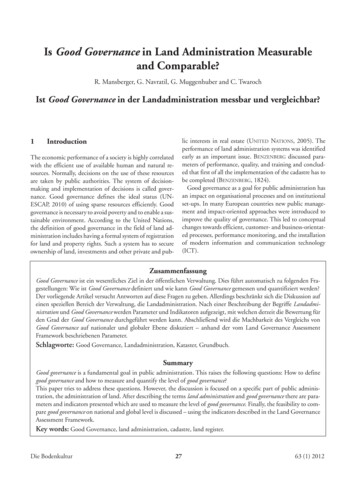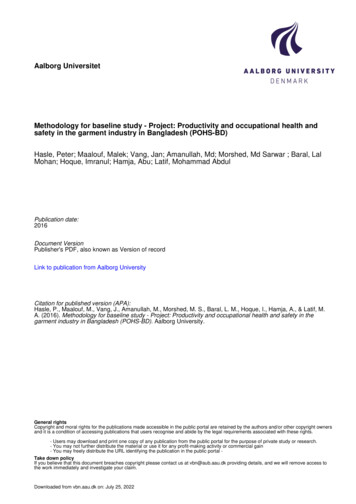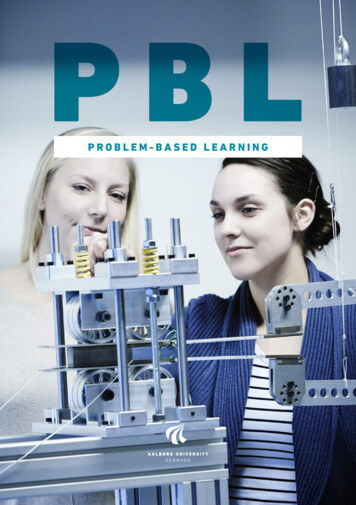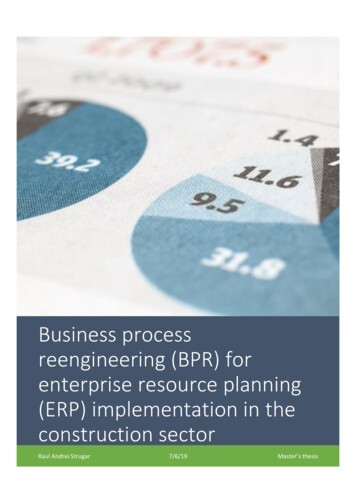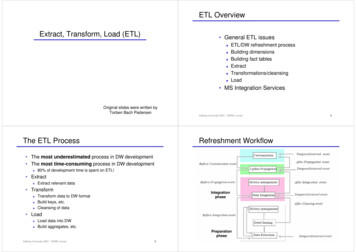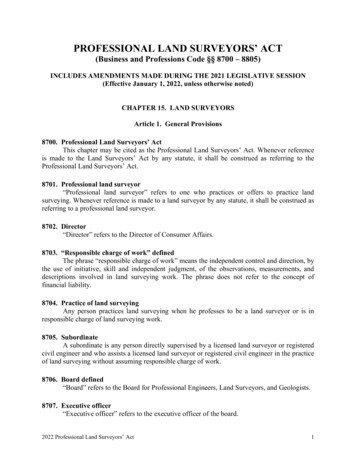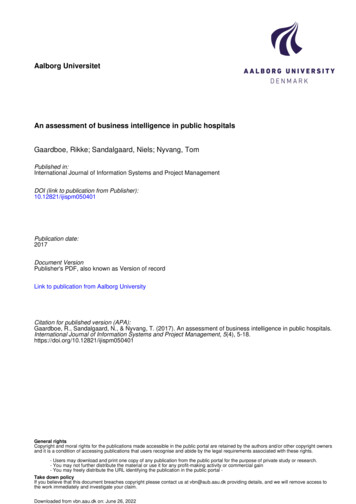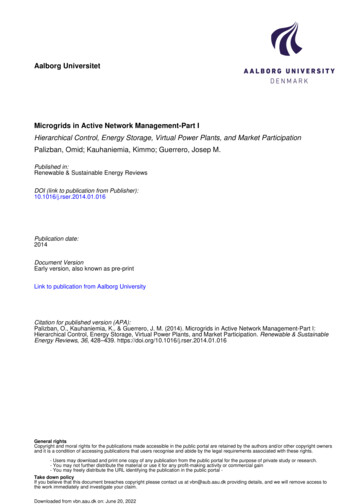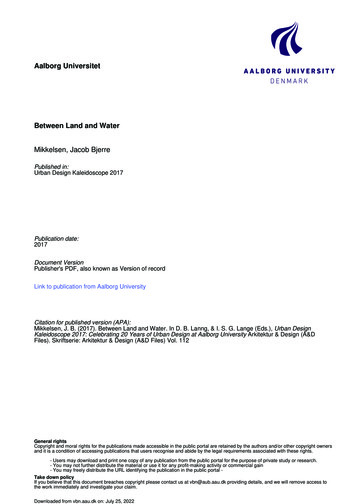
Transcription
Aalborg UniversitetBetween Land and WaterMikkelsen, Jacob BjerrePublished in:Urban Design Kaleidoscope 2017Publication date:2017Document VersionPublisher's PDF, also known as Version of recordLink to publication from Aalborg UniversityCitation for published version (APA):Mikkelsen, J. B. (2017). Between Land and Water. In D. B. Lanng, & I. S. G. Lange (Eds.), Urban DesignKaleidoscope 2017: Celebrating 20 Years of Urban Design at Aalborg University Arkitektur & Design (A&DFiles). Skriftserie: Arkitektur & Design (A&D Files) Vol. 112General rightsCopyright and moral rights for the publications made accessible in the public portal are retained by the authors and/or other copyright ownersand it is a condition of accessing publications that users recognise and abide by the legal requirements associated with these rights.- Users may download and print one copy of any publication from the public portal for the purpose of private study or research.- You may not further distribute the material or use it for any profit-making activity or commercial gain- You may freely distribute the URL identifying the publication in the public portal Take down policyIf you believe that this document breaches copyright please contact us at vbn@aub.aau.dk providing details, and we will remove access tothe work immediately and investigate your claim.Downloaded from vbn.aau.dk on: July 25, 2022
Aalborg UniversitetUrban Design Kaleidoscope 2017Lanng, Ditte Bendix; Lange, Ida Sofie GøtzschePublication date:2017Document VersionPublisher's PDF, also known as Version of recordLink to publication from Aalborg UniversityCitation for published version (APA):Lanng, D. B., & Lange, I. S. G. (Eds.) (2017). Urban Design Kaleidoscope 2017: Celebrating 20 Years of UrbanDesign at Aalborg University. Skriftserie: Arkitektur & Design (A&D Files), Vol. 112General rightsCopyright and moral rights for the publications made accessible in the public portal are retained by the authors and/or other copyright ownersand it is a condition of accessing publications that users recognise and abide by the legal requirements associated with these rights.? Users may download and print one copy of any publication from the public portal for the purpose of private study or research.? You may not further distribute the material or use it for any profit-making activity or commercial gain? You may freely distribute the URL identifying the publication in the public portal ?Take down policyIf you believe that this document breaches copyright please contact us at vbn@aub.aau.dk providing details, and we will remove access tothe work immediately and investigate your claim.Downloaded from vbn.aau.dk on: January 22, 2018
Collective Active MATTERS OF CONCERN / Yamil HasbunChavarria BIG WORDS, MYSTERIOUS MEANINGS ANDPOWER CONSTELLATIONS IN URBAN DESIGN / CecilieBreinholm Christensen DWELLING ON THE MOVE / EliasMelvin Christiansen URBAN TECTONICS WORKSHOP /Jeppe Fink SCENES FROM AALBORG A STUDY OBJECTWATER / Jacob Bjerre Mikkelsen BETWEEN LAND ANDWATER / Peter Frost Møller WHEN DESIGN BECOMESPRACTICE / Lars Dyve Jørgensen & Kent Olav HovsteinNordby WHAT IF WE ADDRESSED CHANGE INSTEADOF WAITING FOR CHANGE TO ADDRESS US? / Ole PihlMIRACLES ON DEMAND / Marianne Rønnow Markussen& Lene Sack-Nielsen CURATORS OF FRAMEWORKS /Jes Zinck Severinsen THEN WHAT DRIVES THE MONEY?/ Elisa Diogo Silva MAPPING GREYSCAPES / TrineRibergaard Skammelsen PLANS ARE WORTHLESS, BUTPLANNING IS INDISPENSABLE / Shelley Smith STEP /Simon Wind A CALL FOR URBAN DESIGN IN SMART CITIES
Urban DesignKaleidoscope 2017Celebrating 20 Years of Urban Designat Aalborg University
Journal series: Arkitektur & Design Skriftserie/A&D Files, Aalborg University, DenmarkISSN no. 1603-6204Volume no. 112 (2017)Editors: Ditte Bendix Lanng & Ida Sofie Gøtzsche LangeLayout: Sofie Rejkjær SvendsenPrint: Nordcolor, Gasværksvej 30 K, 9000 AalborgThe catalogue is published at Urban Design Day 2017, September 29th, CREATE AAU.
With this anniversary publication we celebrate 20 years of urban design at Aalborg University. Thecontributors to the publication are students, graduates, and faculty members, who have generously sharpenedtheir pens and minds for this diverse collection of essays and accompanying illustrations. The resultingcollaborative catalogue celebrates urban design teaching and research at AAU, and the urban design practice bygraduates from this program.Authors have been invited to contribute with a brief essay, focused on a pertinent urban design issue of theirown selection. Together they form a rich collection of subjects, concepts, objects, projects, and questions, whichhave been—and still are—on our minds in urban design throughout the past 20 years. The richness and variationdemonstrated by the catalogue is in keeping with urban design’s orientation towards diverse considerationswhen addressing contemporary urban challenges.The past years of AAU urban design endeavours have demonstrated that urban design is about acting withinnetworks of multiple interests, concerns, stakeholders, and other actors. Urban design is perhaps well conceivedof as a sensibility of the ‘urban-minded’, as Harvard GSD dean José Luis Sert suggested at the world’s firstUrban Design conference in 1956. This somewhat indefinite inception for urban design still persists, and clarityof definition seems to be defied. Rather, in the engaged attempts to operate with synthesis in the ever-changingcomplexity of the urban condition, urban design’s elusive mandate and purpose remains in debate.If attempting to stir up this hornet’s nest of urban design’s contemporary raison d’etre and scope, multipleco-existing positions impose themselves. Just some of these include: Koolhaas’ radical Fuck Context and pushto leave architectural delusions of potency and splendor, next to Gehl’s human-friendly ‘let’s meet betweenthe buildings’ agenda, next to Mostafavi’s optimistic call for a cross-disciplinary sensibility to respond to theecological crisis, next to Harvey’s sturdy emphasis on power, justice, and the right to the city, next to Jacobs’ andAppleyard’s manifesto of e.g., livability, community, and public life as normative goals of urban design.This multiplicity suggests that to be an urban designer demands skillful and flexible navigation across complexissues of cities and countrysides. Urban designers must work with many elements with meticulousness andreadiness. We must strive to continuously adapt to situations and to even be at the forefront of change. Thisalso applies to urban design teaching and research at AAU, as well as to the practices of graduates. For thesereasons, this publication offers its modest space for engaged professionals and students to address the diversityand variation of urban design through what they determine to be pertinent urban design matters.Thus, the contemporary versatility of urban design is reflected in this kaleidoscopic catalogue, addressing suchdiverse issues as urban design’s social ambitions; affective encounters of urban space; the conceptualisationof spaces, landscapes, and buildings; relationships between local sites and global change; ecology; events andculture in the city; urban design’s role in a complex field of interests and actors driving urban developmentand planning; dreams of the future; technologies; continuous urban change; experimental methods; anddisputed concepts. We are proud to present these voices, and we invite you to dive into them. Thanks to all thecontributors for sharing!Last but not least, thanks to the Spar Nord Foundation for its generous funding of this publication, as wellas to the Study Board of Architecture & Design and to the Section of Architecture & Urban Design at theDepartment of Architecture & Media Technology, Aalborg University.Ditte Bendix Lanng & Ida Sofie Gøtzsche LangeSeptember, 2017
index01 Collective Active MATTERS OF CONCERN02 Yamil Hasbun Chavarria BIG WORDS, MYSTERIOUS MEANINGS AND POWER CONSTELLATIONSIN URBAN DESIGN03 Cecilie Breinholm Christensen DWELLING ON THE MOVE04 Elias Melvin Christiansen URBAN TECTONICS WORKSHOP05 Jeppe Fink Scenes from Aalborg - a study object under constant change andthe home of Urban Design06 Andrea Hernandez OUT OF THE MAP07 Ole B. Jensen ROAD08 Hans Kiib URBAN ARCHITECTURE BRIDGING SOCIAL INEQUALITY09 Ida Sofie Gøtzsche Lange APHORISMS OF ARCHITECTURE IN TIME AND SPACE10 Ditte Bendix Lanng RE-AWAKENING UTOPIA11 Gunvor Riber Larsen A CUCKOO’S VIEW12 Lea Holst Laursen THE MULTIFACETED PROFESSION OF URBAN DESIGN13 Gitte Marling URBAN DESIGN MATTERS14 Louise Meier WATER15 Jacob Bjerre Mikkelsen BETWEEN LAND AND WATER16 Peter Frost Møller WHEN DESIGN BECOMES PRACTICE17 Lars Dyve Jørgensen & Kent Olav Hovstein Nordby WHAT IF WE ADDRESSED CHANGE INSTEADOF WAITING FOR CHANGE TO ADDRESS US?18 Ole Pihl MIRACLES ON DEMAND19 Marianne Rønnow Markussen & Lene Sack-Nielsen CURATORS OF FRAMEWORKS20 Jes Zinck Severinsen THEN WHAT DRIVES THE MONEY?21 Elisa Diogo Silva MAPPING GREYSCAPES22 Trine Ribergaard Skammelsen PLANS ARE WORTHLESS, BUT PLANNING IS INDISPENSABLE23 Shelley Smith STEP24 Simon Wind A CALL FOR URBAN DESIGN IN SMART CITIES25 You NOTES: URBAN DESIGN ON YOUR MIND
01CollectiveactiveMatters of concernUrban design shapes our environment and our lives; and everybody is involved. It is impossible to not take partin the environment within which we live. City development has evolved over the ages, changing depending onthe history, culture and ideals of society. Also, in the times we live in now, urban design’s roles are continuouslychanging. The question of ‘What can, and what should, the roles of urban designers be now?’ comes to theforefront.To look for answers, we have embarked on a collective journey, launched by a list of ‘matters of concern’1. Weuse an exquisite corpse technique. Invented by surrealists, this technique is a method of collaborative process,where a collection of words is made by each member and are then collectively assembled. It is genuinely openminded and collective. Thus, we invite you to read and add your perspective too.A. How can the urban designer (re)act responsibly within the on-going formation of a city? What are the publicconsequences of our urban designs? What publics should we design with and for, and how do we get to knowthem? How, exactly, can we be the change we wish to see in the world?B. My sister once said: You only think about dead stones. Wait, what?! Wake up, urban designers! If we wantto build cities for people, we need to build with people! Let’s listen and speak. Let’s understand and contribute.Let’s build on and with a sense of community.C. What is urban design about? It’s about emphasising the experiences and the senses. It’s about doing thingsdifferently in a way that will nourish communities and give people a voice. It’s about the early collaboration ofpeople, designers and planners. It’s about creating something together that will leave a trace.D. Democratic design is not only participation from different parties but also the embedded understanding ofthe urban cultural, social, political and economic aspects of the place.E. We must be aware that this sense of community will not be found in a masterplan. It’s time to stop taking thebird’s eye view and instead start looking at what is happening at the street level. The small scale is the one thatallows mistakes and ever-changing solutions.F. It is interesting to think to what extent citizens are shaping the city, and how the city moulds its citizensin return. It begs the question of responsibility as well as active participation when trying to explore such asymbiosis. The discipline of urban design should use these basic concepts to effectively improve both parts.G. The city is not a product, nor a result of a well-considered plan. It is a story, plotted through time withever-changing conditions, and is written by its residents. It is time for designers and planners to realise theinfluence people have in cities, and time to start working together on a small scale to create spaces built by andfor stronger communities.1Latour, Bruno, 2004, ‘Why has critique run out of steam? From matters of fact to matters of concern’, Critical Inquiry, 30(2), pp.225-48.
Urban design concerns – Join the conversation!Copyright: Collective Active.
02yamil hasbunchavarriaBig words, Mysterious Meanings and Power Constellations in UrbanDesignHow did it come to be that I, a Costa Rican urban designer trained in Denmark and in Germany, constantlyfind myself mobilising complex urban design concepts, acquired throughout my student years in Europe, soseamlessly in my home country? Do these concepts mean the same thing for everyone everywhere? Do wealways know what they actually mean? This short essay does not intend to provide answers to these questions,but aims instead, hopefully, to provoke a snowball effect of questions that arguably remain ignored in ourdiscipline, and that may be far more delicate and widespread then they first seem.For example, how often do we find ourselves in a situation in which, while attempting to explain a specificconcept from our field such as ‘resilience’ or ‘sustainability’– we feel as if we are coming up short of a coherentanswer? We might tell ourselves that not remembering textbook definitions is okay as long as we are able toperform our tasks by making use of our particular ‘expert’ skills, which are partly acquired empirically.However, does our clumsy answer come out as a mishmash of ‘technical’ words that does not so much convince,but rather obscures the explanation by adding a cascade of confusing language? Doesn’t this contradict the open‘participatory’ concept that is supposedly so praised in our field? Perhaps, not remembering a precise definitionof a certain concept is not necessarily a consequence of our imperfect memory, but at times the result of thoseconcepts themselves being ‘fuzzy’ at best, or a total mystery at worst.If the definition of these concepts is often a mystery for us, isn’t it likely that they are obscure to our colleaguesas well? Furthermore, if the answers we seek are simply found in the definitions provided in our old universitytextbooks, wouldn’t that automatically render those who wrote these concepts all-powerful? Furthermore, whyfollow these specific works and not those hundreds of others that argue otherwise? Didn’t those authors writetheir ideas in specific historical and geographical contexts that are most likely different from our ‘here’ and‘now’?Hence, how can a Costa Rican designer unproblematically mobilise concepts like ‘resilience’ or ‘smartness’(coined in European post-industrial societies) in a Central American country that had no significant industrialpast and expect equal outcomes? Isn’t repeating these concepts carelessly a way of reproducing a one-directionalflow of knowledge from the global North to the global South? Doesn’t this asymmetrical transfer ultimatelyaccentuate cultural, ethnical and economic imbalances? Is knowledge produced in the South somehow destinedto be less valuable than its northern equivalent, or can the North learn from the South too?As I suggested above, the answer doesn’t seem to lie in the robustness, clarity or universality of the designconcepts so far coined in the global North.These provocative questions call for a critical self-reflection about the power constellations we designersreproduce knowingly and unknowingly, as we mobilise the taken-for-granted concepts of our discipline whileplaying the role of ‘experts’ in our highly politicised fields.
Top and bottom: Performative spatial construction of San Jose, Costa Rica, where ‘homegrown’ and ‘exotic’ narratives continuously intermingle.Copyright: Yamil Hasbun Chavarria.
03Cecilie BreinholmchristensenDwelling on the Move1Dwelling is related to building a physical territory to provide a sense of safety as well as to rhythms and routines,a bodily habituation of place and of getting so familiar with this place that it eventually becomes an extension ofthe self. Dwelling is to distinguish private spaces from public spaces, thereby organising social relations. Finally,dwelling is a matter of personal identification, of seeing oneself in one’s surroundings. If we can dwell in aspace, we can feel at home. Consequently, if we can dwell on the move, we can maintain a coherent sense ofself, even though we are moving through time and space, sometimes at very high speeds. So how can we dwellon the move? And which role does the design of our physical surroundings play in this?I had been commuting between Copenhagen and Odense for about half a year. After a week off it was time togo to work in Odense again. I didn’t really want to go, I was tired and it was raining. However, already on theS-train I started to feel a small joy of being ‘on the way’ again; totally unexpected. Just getting on board the ICfast train towards Odense woke the expectation of what would come – and I couldn’t wait for the train to getgoing. I had actually missed it! The train and the train trip, the comfort of being transported, the sensation ofthe train’s engine that starts, the train’s silent puffing and the rhythmic sound from the tracks. I realised how Ihad missed going somewhere with a purpose, how being at work actually made me feel important to someone.I also noticed everything anew again. All the special commuter practices of ‘building a territory’ claimed byseat reservations and demarcated by take-away coffee cups, morning bread in paper bags, headphones, smartphones and computers. Even on the platform, I had recognised several of the other commuters, their faces androutines, and I had felt a strong connection with them somehow, even though I had never really spoken directlyto any of them.Dwelling on the move is just as much an ability of the single commuter as it is enabled or prevented by designdecisions and the actual layout of the train, the platforms and stations, the connecting roads, busses etc. Theseats on the IC trains make it easy to build a private space, but difficult to get in touch with anyone other thanthe eight people you can see around you. The poor internet connection can prevent you from maintaining socialrelations, but gives you something to talk about with fellow passengers. Dwelling is what you make of yoursurroundings, how comfortable you can feel in them physically, socially and personally. Furthermore, it is howthe design of the physical surroundings allows you to make yourself comfortable. In summary, commuting isnot just about riding the train. It is just as much about being able to – and allowed to – dwell on the move.1This contribution is based on a paper presentation at the C-MUS Material Mobilities conference in November 2016 with the same title.
The train window layout provides a sense of security and a view of the world. Copyright: Cecilie Breinholm Christensen.
04Elias MelvinChristiansenUrban Tectonics WorkshopAs architects, we passionately describe spatial experiences that are shaped by our envisioned architecture, butwhen it comes to presenting structural, constructional, or technical aspects, we seem rarely as articulate. Withinan increasingly complex construction industry, this becomes very obvious. Today, we need design professionalswho are able to act across the boundaries of architecture, urban design, and engineering, which is crucial toaddress urban challenges like climate change, segregation, and densification. This is where tectonic theories arepromising, as they inherently bridge technical solutions and spatial experiences.Tectonic theories, building on Kenneth Frampton’s definition of tectonic as “the art of construction”1, andMarco Frascari’s writings on joining “the mental construing and the actual construction”2, were carried out inrelation to Interiority at A&D, Aalborg University by Marie Frier-Hvejsel3, when she linked the notions gesture,describing what the space does, and principle, describing how the space does it. Following this, Urban Tectonicshave recently been coined to introduce tectonic theories into the field of urban design, centred around thePhD “Urban Tectonics - Integrating the architectural volume and the urban surface”. The Urban TectonicsWorkshop on the 6th semester of the architecture and urban design bachelor programme, originates from thisagenda.The workshop is a condensed course consisting of lectures, pin-ups, discussions, and physical model building.The students work in groups, analysing a specific project by focusing on describing a spatial quality, a gesture,within the project, and subsequently its structure, the principle that realises that spatial experience. The studentsare finally asked to articulate their results in a white section model that focuses on the specific detail, a sectionthrough the urban and architectural space that they have analysed (Illustrations). The workshop concludes witha group discussion where the students are asked to reflect upon the workshop and the potentials of tectonicsin relation to urban design.The Urban Tectonics Workshop is an attempt to address urban design through tectonic theories, a ‘tectonic lens’perhaps. The students seem to have enriched their vocabulary and understanding of the relationship betweenthe spatial experience and technical solutions through the notions of gesture and principle. Subsequently theywere able to have deeper discussions, and thus qualifying their collaborative work in designing architecturaland urban spaces. Additionally, the section models, compellingly, visualised the spatial relationship between thearchitectural and urban spaces, and assisted the students in disregarding the boundaries of architecture, urbandesign, and engineering.Prospectively, research will seek to unfold the potentials of Urban Tectonics, and, hopefully, become a viabletool for the next generations of architects and urban designers.123Frampton, K., 1995, Studies in Tectonic Culture: The Poetics of Construction in nineteenth and twentieth century architecture, MIT Press, MassachusettsFrascari; M., 1984, The Tell-the-Tale Detail, VIA no. 7, Graduate School of Fine Arts, University of Pennsylvania, p. 23-37.Hvejsel, M. F., 2011, Interiority - A critical theory of domestic architecture, Skriftsserie 44: Institut for Arkitektur og Medieteknologi, Aalborg University
Top: Group 1 - Blox by OMA. Copyright: Elias Melvin Christiansen.Bottom: Group 2 - Mediatheque by Toyo Ito. Copyright: Elias Melvin Christiansen.
05jeppefinkScenes from Aalborga study object under constant change and the home of urban designFlashback to 2004. I participated in a municipal city walk. We passed a busy four-track road and some worn outwarehouses before we reached the Limfjord. The guide exclaimed, ‘We’re going to reclaim the waterfront forthe city. In a few years this place is going to be bustling with urban life!’Fast forward to 2008. Many debates, public quarrels, political power struggles and various design versions of thewaterfront later. I passed the waterfront in the morning. Workers were rolling out grass. Later that day I passedthe other way. Now there was a lawn and a group of people were hanging out on it. In passing, I think: Grass?Could it really be so easy to create the framework for urban life?Flashback to 2007. I pass Nordkraft at Østerbro, where they have just started converting the old power plantinto a cultural centre. The beer drinkers, who hang out in the area, are gathered in front of their regular pub“Kanal Caféen” to watch the work in progress. Within a year, the pub is closed and the beer drinkers have leftthe area. I wonder where they went, and why they didn’t want to be there anymore and how to design goodurban spaces for beer drinkers?Flashback to 2008. I attended a workshop at Østre Havn. The industry is gone and it has left a stunninglandscape of empty silos and abandoned wharves. The workshop is about how to attract urban life to the areathrough an experimental approach and how urban life can affect the conversion of Østre Havn into an excitingnew neighbourhood. All options are open!Fast forward to 2017. I passed through Østre Havn. The landscape is unrecognisable. Apart from the activitiestaking place in the harbour basin itself, the urban life has been replaced by construction cranes. I wonderwhether there will still be room for experiments when the cranes have moved out.This way, scenes and questions continue to evolve as I move through the city and observe its many differentlayers, places and narratives.Aalborg is an ever-changing arena – a 1:1 working model undergoing rapid development.Every day, the city is transformed, redesigned and reconsidered, and there is always room for improvements.As a study object, Aalborg has helped shape new generations of urban designers for 20 years, and around theworld urban designers who have graduated from Aalborg University have made it their profession to ask criticalquestions and to transform realities that surrounds them – because there is always room for improvement andthere are infinite places and issues to address.However, the basis upon which the professional urban designers can ask the right critical questions has beenformed right here in our city – Aalborg.As a study object, our city will continue to make itself available, because Aalborg is like a miniature world withan infinite number of issues that need to be addressed.
An ‘under the table discussion’ taking place during the workshop at Østre Havn in 2008. Copyright: Jeppe Fink.
06AndreaHernandezOut of the mapI never imagined how aeromobilities could affect small urban ecosystems. Margarita, considered a paradise dueto its beaches and beautiful landscapes, was a popular destination for Americans and Europeans during the1990s. Popular beaches such as El Yaque, which is a small community whose main income comes from tourism,are well-known for skysurfing, water activities and a strong sense of community. This area has been built aroundgood weather and wind conditions. In this respect, sky surfers, many of them foreigners, started to build thiscommunity based on their passion for the sport. What I love about this area is the scale and the combination ofurban and natural qualities. It is possible to walk the entire neighbourhood at any time and still have the feelingof an ‘in progress-development’ town and a virgin-natural atmosphere. The sense of community creates theurban character; the residents know each other very well, help each other, and they make you feel at home. Theurban ecosystem is built around the sense of community, the natural environment and the passion for sport.The community has been grown with locals and internationals, who mixed and cohabitated here for the last 19years. This international community of mixed nationalities and cultures has a spirit that is part of the island’sidentity. Both working and living activities are merged in space and place.After almost three years of not having been there, it seems as if nothing has changed. However, the quantityof international tourists has decreased dramatically over the last few years, mainly due to the current lack ofconnectivity with the island, which makes it a hassle for them to get to the island. In addition, the economic andpolitic interests has catalysed and affected the current situation.“The direct flights from Europe were cancelled on the island about seven years ago. All the logistics interms of mobility were affected; nobody wants to make two or more flight connections to get here. Thataffected our transfer-regional and local mobility”1I was impressed by how important a large scale of connections is; in this case, aeromobilities are necessaryto keep urbanity alive. The cancellation of direct flights (due to political decisions and monetary interests)had a significant impact on a large part of the economy and the local mobilities and communities. Therefore,we can reflect that many aspects can catalyse (weather-landscape conditions, passion, cross-cultural activities,connectivity and mobilities) and affect (lack of mobilities, political interests, cultural crises) local urban areas.The scale is also an important aspect to consider for the sense of community in urban ecology building. Theconditions of the location in terms of weather, namely the strong wind, was able to connect different nationalitiesin a unique place, breaking barriers in terms of languages and cultures and creating, in turn, a mixed generationthat reflects the international-local character that built the place up. Aeromobilities thus are not far away fromthe small-scale development or simply big scale move from A to B; they can become an unexpected catalyst anda driving force for merging worldwide cultures in a specific place and keeping them alive.1Quote: The German Manager, Atti Hotel
Top: Mobility map then and now for El Yaque, comparing the urban mobility and activity before and after international flights were cancelled. Copyright: Andrea Hernandez.Bottom: El Yaque beach collage then and now. An atmosphere of the lack of aeromobilities after the effect. Copyright: Andrea Hernandez.
07ole b.jensenROADRecent statistics show that we have now passed 1.2 billion cars on the roads and are looking at a projectedstaggering 2 billion cars by 2035 globally. We all know the omnipresent object of the road, and yet it carriesdeeper meanings than simply being a transportation surface.According to the OECD, a road is ‘a line of communication using a stabilized base other than rails or airstripsopen to public traffic, primarily for the use of road motor vehicles running on their own wheels’. Most often,we tend to think of roads as messy, noisy, hard, landscaped, busy, polluted, or jammed; all features of an objectthat have to do with its immediate function as a surface for vehicular movement. However, the communicationdimension is a
With this anniversary publication we celebrate 20 years of urban design at Aalborg University. The contributors to the publication are students, graduates, and faculty members, who have generously sharpened
